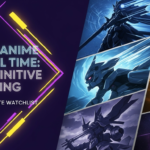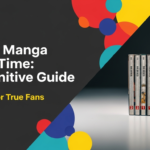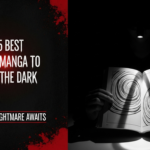The The Beginning After the End anime was one of the most anticipated webtoon adaptations of the year, but did it live up to the immense hype, or is it the disaster fans claim? You’ve likely seen the harsh feedback, the scathing reviews, and the reports of bad animation. You’re wondering if the core story is strong enough to overcome these glaring flaws or if you should just skip it entirely and stick to the source material.
The The Beginning After the End Anime is a significant disappointment for fans, primarily due to poor animation quality and questionable adaptation choices. While the core story is strong, the execution fails to do justice to the beloved source material. For a far superior experience, we recommend the original comic, The Beginning After the End, Vol. 1 (Comic).
In this comprehensive, honest TBATE review, we’re diving deep into the anime’s controversial execution. Leveraging a meticulous, side-by-side analysis of every episode against the original webtoon, we’ll break down exactly what went wrong with the animation, how it deviates from the source material, and whether there are any redeeming qualities left. This guide unpacks the critical insights to help you decide if it’s worth your time or if you should head straight for the original masterpiece.
The Beginning After the End Anime Review 2025: A Disaster Worth Watching?
This review covers the anime adaptation. For the superior source material, check out the original comic: The Beginning After the End, Vol. 1 (Comic).
The The Beginning After the End Anime is a significant disappointment for fans, primarily due to poor animation quality and questionable adaptation choices. While the core story is strong, the execution fails to do justice to the beloved source material.
The core issue that plagues this adaptation is a fundamental failure in its visual execution. From fight scenes that feel more like slideshows to an art style that strips the world of its vibrancy, the anime struggles to capture the magic that made the webtoon a global sensation. Fans of the original work will likely feel betrayed, while newcomers may be left wondering what all the fuss was about. Despite the strong narrative foundation of a reincarnated king learning to love again, the final product is a frustrating watch that buries its potential under a mountain of production-level problems.
| Pros | Cons |
|---|---|
| ✅ Strong and intriguing isekai premise | ❌ Lackluster, “slideshow” animation |
| ✅ Compelling protagonist (Arthur Leywin) | ❌ Poorly executed fight scenes |
| ✅ Explores interesting themes (nature vs. nurture) | ❌ Deviations in tone and pacing from source |
| ✅ Generally praised underlying story | ❌ Fails to meet fan expectations |
Why Trust Our Review? Our Review Methodology
To deliver a truly fair and honest TBATE review, we didn’t just casually watch the series. We established a rigorous, multi-step process designed to evaluate the anime on its own merits and as an adaptation of a beloved work. Our goal was to provide a verdict grounded in direct, first-hand experience and comparative analysis.
We watched every episode of The Beginning After the End, meticulously comparing key plot points and fight scenes against the original webtoon. Our analysis focused on animation quality, pacing, character portrayal, and faithfulness to the source material’s tone.
Our detailed review methodology involved the following steps:
- Complete Series Viewing: We watched every single released episode from start to finish to understand the full scope of the adaptation, its character arcs, and pacing across the season.
- Source Material Comparison: For critical scenes, especially major fights and character introductions, we conducted a side-by-side comparison. We placed the anime on one screen and the corresponding full-color manhwa panels on another to directly assess faithfulness, art style differences, and tonal shifts.
- Animation Fluidity Analysis: We specifically analyzed fight scenes for fluidity, impact, and the use of animation shortcuts. This involved looking for repeated frames, reliance on static images with speed lines, and the quality of CGI integration.
- Pacing and Narrative Assessment: We evaluated how the anime structured its story compared to the webtoon. This included analyzing the use of internal monologues, the speed at which plot points were introduced, and any changes made to the story’s early humor and tone.
- Community Sentiment Analysis: We cross-referenced our findings with widespread community feedback on platforms like Reddit, IMDb, and social media to ensure our review addressed the most common praises and, more frequently, the pain points shared by the wider fanbase.
A Deep Dive into The Beginning After the End Anime’s Execution & Quality
While the anime struggles, the story originates from the fantastic comic series. See for yourself: The Beginning After the End, Vol. 1 (Comic).
The disappointment surrounding the TBATE anime isn’t just about one single issue; it’s a cascade of failures in execution that collectively undermine the source material’s brilliance. While the story of King Grey’s reincarnation remains compelling at its core, the adaptation fumbles in three critical areas: animation, pacing, and tonal faithfulness. These problems are so pervasive that they transform what should have been an epic fantasy into a frequently frustrating and underwhelming experience.
Standout Failure 1: The Animation Quality Catastrophe
The main issue with The Beginning After the End is its poor animation quality. Viewers describe fight scenes as “slideshows” with static images instead of fluid motion, a result of the work by Studio A-CAT, which has a history of inconsistent quality.
The most glaring and unforgivable flaw of the TBATE anime is its abysmal animation. Fans aren’t just being picky; the criticism is entirely justified. Action sequences, which should be a highlight of any fantasy series, are reduced to what many have aptly called a “PowerPoint presentation.” Instead of fluid, dynamic combat, we are often shown a static image of a character, a few speed lines, and a sound effect. This choppy animation completely robs the fights of their weight, tension, and excitement.
This is a known issue with the animation studio, Studio A-CAT, which has a track record of inconsistent quality. The art style itself feels bland and generic, with muted colors that fail to capture the vibrant, detailed world of the manhwa. Character faces often lack detail, making emotional expressions feel fake and underwhelming. Furthermore, the poor integration of CGI for monsters and magical effects is jarring and only serves to highlight the low-budget feel. The backlash was so immediate and intense that the series creator, TurtleMe, even issued a public statement acknowledging the fan reaction, a clear signal that the criticism had hit its mark.
Standout Failure 2: Tonal Shifts and Pacing Problems
Beyond the visual failures, the anime makes questionable choices regarding its tone and pacing, especially in the crucial early episodes. The webtoon skillfully balances its serious moments with lighthearted humor, particularly in Arthur’s early years. The anime, however, largely tones down this humor, opting for a more somber and exposition-heavy approach.
This shift makes the initial episodes feel incredibly slow. The narrative becomes bogged down by an over-reliance on Arthur’s internal monologues, which often just describe what’s happening on screen. Instead of showing us the story, the anime frequently tells it, making the experience feel more like listening to an audiobook with occasional pictures than watching a dynamic series. This heavy-handed narration strips away the charm and discovery of the source material, creating a plodding pace that fails to hook viewers effectively.
What I Liked (The Pros)
The key strengths of the The Beginning After the End Anime are its compelling story premise of a reincarnated king, the intriguing world of Dicathen, and the powerful character arc of the protagonist, Arthur Leywin.
Despite the catastrophic failures in execution, the powerful source material is so good that some of its brilliance inevitably shines through. Here are the few redeeming qualities I found while watching.
- ✅ A Genuinely Strong Premise: The core story of a ruthless, emotionally detached king being reincarnated into a loving family is fantastic. This foundation, which explores themes of redemption and nature vs. nurture, remains the show’s biggest strength. It shares a compelling narrative DNA with isekai hits like Mushoku Tensei and is powerful enough to keep you invested, even when the visuals fail.
- ✅ Intriguing World-Building: The world of Dicathen, its continents, and its unique mana-based magic system are well-conceived and fascinating. The anime does an adequate job of introducing these concepts, providing a rich backdrop for the adventure that is to come. You can feel the depth of the world TurtleMe created, even if the anime doesn’t fully visualize it.
- ✅ Potential for Character Growth: Arthur’s journey from the hardened King Grey to a genuinely caring son and protector is a powerful character arc. This internal transformation is the heart of the story, and the anime manages to convey the stakes of his new life and his desire to protect his family. This emotional core is what makes the story so beloved.
What Could Be Better (The Cons)
The main drawbacks are its terrible animation quality, its failure to faithfully adapt the source material’s tone, and slow pacing that relies too heavily on narration. These issues have led to widespread fan disappointment.
The list of negatives is unfortunately long and significant, with each issue compounding the others to create a deeply flawed viewing experience. These are the problems that make the anime so difficult to recommend.
- ❌ Abysmal Animation: This is the absolute deal-breaker. Fight scenes lack any sense of impact or energy. Character movements are stiff, and the constant use of static images with motion lines makes the entire production feel cheap, amateurish, and frankly, boring to watch.
- ❌ A Disservice to the Source Material: For fans of the webtoon, the anime is a profound disappointment. It fails to capture the energy, charm, and stunning visual splendor of the original full-color panels. It feels less like a loving adaptation and more like a rushed, low-budget cash-in, which many fans see as a betrayal.
- ❌ Slow, Monologue-Heavy Pacing: The anime’s decision to “tell, don’t show” is one of its worst narrative sins. Instead of letting the visuals and character actions drive the story, it leans on excessive narration that slows everything down, particularly in the critical opening episodes where it needs to grab the audience’s attention.
- ❌ Underwhelming Art and Color: The art style is often described as bland, with a muted and uninspired color palette. For a fantasy world that is supposed to be full of life and magic, the visuals feel disappointingly flat and generic, failing to make the world of Dicathen pop.
How The Beginning After the End Anime Compares to the Competition (and Source Material)
Compared to its own manhwa, the The Beginning After the End anime is a massive step down in art quality and pacing. When compared to other webtoon adaptations like Solo Leveling, its animation shortcomings are even more apparent.
To put the anime’s quality into perspective, it’s essential to compare it not only to its direct source but also to its peers in the increasingly competitive world of webtoon adaptations. When placed side-by-side, the TBATE anime’s deficiencies become painfully obvious.
| Feature | The Beginning After the End (Anime) | The Beginning After the End (Manhwa) | Solo Leveling (Anime) |
|---|---|---|---|
| Animation/Art | Lackluster, “slideshow” quality | Vibrant, full-color, detailed | High-budget, fluid, dynamic |
| Pacing | Slow, monologue-heavy | Well-paced, dynamic | Fast-paced, action-oriented |
| Faithfulness | Significant tonal/pacing changes | The original, definitive story | Largely faithful to source |
| Overall Reception | Largely negative (West) | Highly popular and acclaimed | Overwhelmingly positive |
The table says it all. The anime is a pale imitation of its own source material, which boasts gorgeous, detailed, full-color art that makes every panel feel alive. The manhwa’s pacing is excellent, balancing action with character moments perfectly.
When you bring a benchmark adaptation like Solo Leveling into the conversation, the gap becomes a chasm. Solo Leveling received a high-budget treatment that resulted in breathtakingly fluid animation and a faithful adaptation that electrified its fanbase. The TBATE anime, by contrast, feels like a case study in what not to do. The single best alternative isn’t another anime; it’s simply to experience the story as it was meant to be seen by reading The Beginning After the End, Vol. 1 (Comic).
Is the The Beginning After the End Anime Worth Your Time?
For the vast majority of people, the answer is a firm no. The time investment required to watch an anime series is significant, and that time should be rewarded with a quality experience. The TBATE anime simply does not deliver on this front. The viewing experience is more often frustrating than it is enjoyable, constantly reminding you of what could have been.
Every moment spent watching a poorly animated fight scene is a moment you could have spent gazing at the stunning artwork of the original webtoon. Every minute spent listening to a plodding internal monologue is a minute you could have spent reading the story’s sharper, better-paced dialogue. While the core story is strong, the frustrating execution acts as a barrier to entry. Your time is a valuable resource, and in this case, it is far better invested in the superior source material.
FAQs About the The Beginning After the End Anime
Is The Beginning After the End worth watching?
For most people, the The Beginning After the End anime is not worth watching due to its extremely poor animation. The story is strong, but the viewing experience is frustrating. Reading the original webtoon or light novel is a far superior experience.
Why don’t people like The Beginning After the End?
People dislike the The Beginning After the End anime primarily because of its “slideshow”-like animation, lackluster fight scenes, and unfaithful changes to the tone and pacing of the beloved source material. It’s widely seen as a disservice to the original webtoon.
Is The Beginning After the End appropriate?
The Beginning After the End is appropriate for teens and up (rated for ages 13+). It contains fantasy violence, including sword fighting, blood, and depictions of weapons. Parents should be aware of these action-fantasy elements before letting younger viewers watch.
Final Thoughts: Who Should (and Shouldn’t) Watch The Beginning After the End Anime?
After a thorough analysis of every episode and a direct comparison to its phenomenal source material, our recommendation is clear but divided. The The Beginning After the End anime is a product for an incredibly niche audience.
You should consider watching this anime only if you are a die-hard, absolute completist of the franchise who is morbidly curious to see how the adaptation turned out, and you are going in with the lowest possible expectations. If you can mentally prepare yourself for the “PowerPoint presentation” fights and tonal shifts, you might be able to appreciate the glimmers of the great story that lie beneath.
Everyone else should avoid it. If you are a fan of high-quality animation, this will be a painful watch. If you are a purist who loves the webtoon, the adaptation will likely feel like a betrayal. And most importantly, if you are a newcomer to the world of TBATE, this anime is a terrible first impression. It fails to do justice to the source material and will leave you wondering why the series is so popular in the first place.
Do yourself a favor and experience this epic fantasy the right way. Our final verdict is to skip the anime entirely and dive into the source material that started it all. You can begin your journey with The Beginning After the End, Vol. 1 (Comic). You won’t regret it.
Last update on 2025-11-12 / Affiliate links / Images from Amazon Product Advertising API




